Function construction and sorting
1. Import jar package
2. Add file parser
3. Successfully set up the login success interface
4. Jump to the add interface through the "add Avatar" function of the interface
5 add the necessary Ajax file upload JS component
6. Realize the upload function and deploy the local gallery to the Tomcat server
7. Get the picture, bind the user's Avatar through the database and add it to the success interface
Import, upload and download required jar files
<dependency>
<groupId>commons-fileupload</groupId>
<artifactId>commons-fileupload</artifactId>
<version>1.3.3</version>
</dependency>
Add file parser and spring_ mvc. In XML
<bean id="multipartResolver" class="org.springframework.web.multipart.commons.CommonsMultipartResolver">
<property name="defaultEncoding" value="utf-8"></property><!--Post upload code-->
<property name="maxUploadSize" value="104857600"></property><!--Upload size limit-->
</bean>
Set up the success interface and add the jump of "Avatar adding interface"
<!DOCTYPE html>
<html lang="en">
<head>
<meta charset="UTF-8">
<title>Information management system interface</title>
<link href="css/style.css" rel="stylesheet" type="text/css" />
<style type="text/css">
*{
margin: 0px;
padding: 0px;
}
</style>
<script src="js/jquery-1.8.3.min.js"></script>
<script type="text/javascript">
$(function(){
var account=window.sessionStorage.getItem("account");
var newFileName=window.sessionStorage.getItem("newFileName");
console.log(newFileName+" 111");
if(account==null){
location.replace("login.html");
return;
}
$("#accountId").html(account)
})
//Implementation of safe exit function
function exit(){
if(confirm("Are you sure you want to exit?")){
window.sessionStorage.removeItem("account");
$.get("login/loginOut",function (res) {
location.replace("login.html");
})
}}
</script>
</head>
<body>
<table border="1" cellspacing="0" cellpadding="0" width="100%" height="100%">
<tr style="background:url(images/topbg.gif) repeat-x;">
<td colspan="2">
<div class="topleft">
<img src="images/logo.png" title="System home page" />
</div>
<div class="topright">
<ul>
<li><span><img src="images/help.png" title="help" class="helpimg"/></span><a href="#"> help</a></li>
<li><a href="#"> about</a></li>
<li><a href="#" target="_ Parent "onclick =" exit() "> Exit</a></li>
<li id="imgId"><a href="upload.html" target="rightFrame">Upload Avatar</a></li>
</ul>
<div class="user">
<span id="accountId"></span>
</div>
</div>
</td>
</tr>
<tr>
<td width="187" valign="top" height="100%" style="background:#f0f9fd;">
<div class="lefttop"><span></span>Operation menu</div>
<dl class="leftmenu">
<dd>
<div class="title">
<span><img src="images/leftico01.png" /></span>
<a href="">management information </a>
</div>
</dd>
</dl>
</td>
<td>
<iframe name="rightFrame" src="list.html" width="100%" height="600"></iframe>
</td>
</tr>
</table>
</body>
</html>
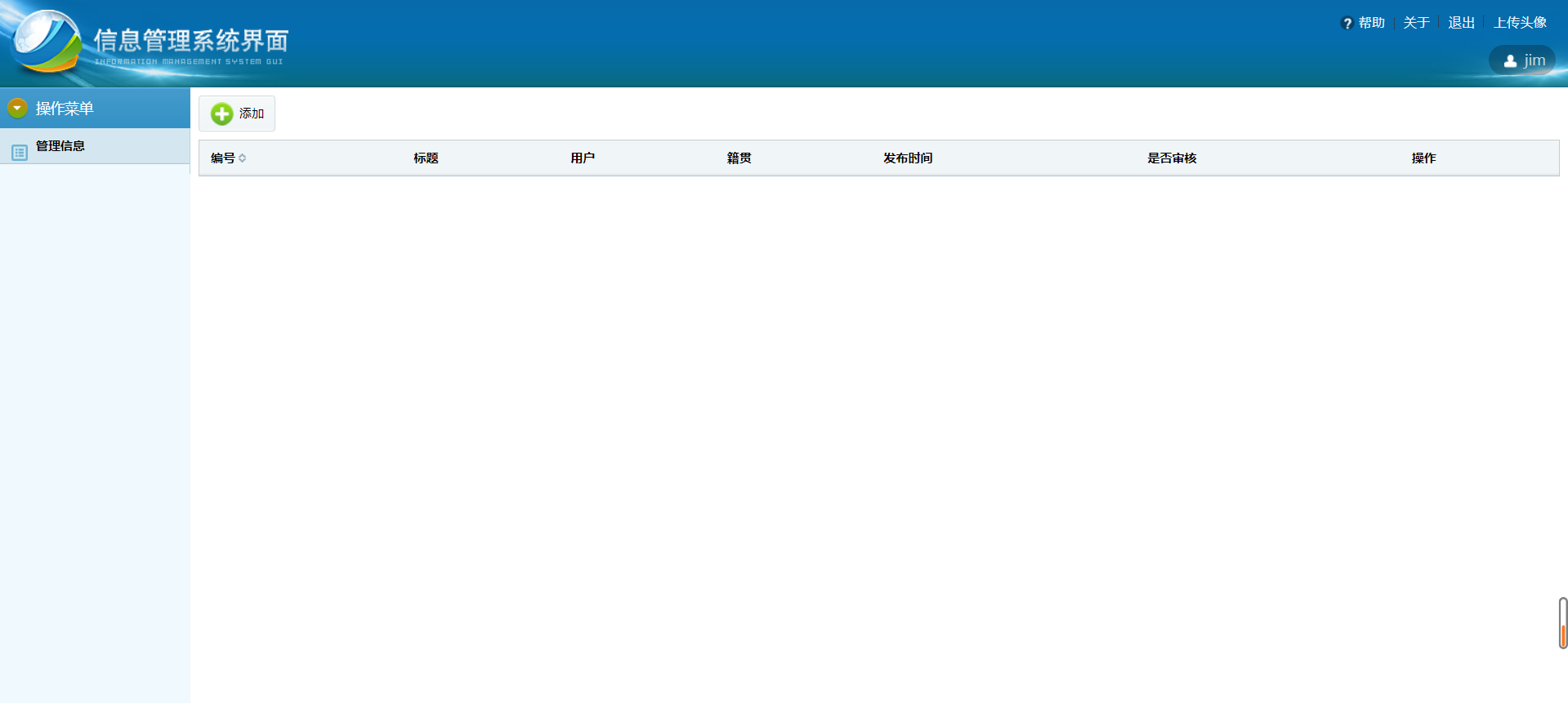
Note: in this case, upload HTML (add avatar) interface if we want to realize the function of adding files, we must add relevant Ajax fileUpload JS component to realize this function
ajaxfileupload. Add JS component
ajaxfileupload. The source code of JS component is as follows. Readers can import it into their own folder and pay attention to the address label
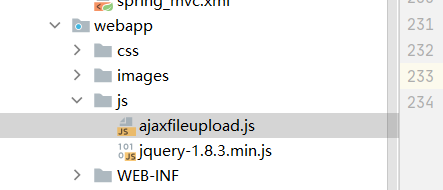
jQuery.extend({
createUploadIframe: function(id, uri)
{
//create frame
var frameId = 'jUploadFrame' + id;
if(window.ActiveXObject) {
var io = document.createElement('<iframe id="' + frameId + '" name="' + frameId + '" />');
if(typeof uri== 'boolean'){
io.src = 'javascript:false';
}
else if(typeof uri== 'string'){
io.src = uri;
}
}
else {
var io = document.createElement('iframe');
io.id = frameId;
io.name = frameId;
}
io.style.position = 'absolute';
io.style.top = '-1000px';
io.style.left = '-1000px';
document.body.appendChild(io);
return io
},
createUploadForm: function(id, fileElementId)
{
//create form
var formId = 'jUploadForm' + id;
var fileId = 'jUploadFile' + id;
var form = $('<form action="" method="POST" name="' + formId + '" id="' + formId + '" enctype="multipart/form-data"></form>');
var oldElement = $('#' + fileElementId);
var newElement = $(oldElement).clone();
$(oldElement).attr('id', fileId);
$(oldElement).before(newElement);
$(oldElement).appendTo(form);
//set attributes
$(form).css('position', 'absolute');
$(form).css('top', '-1200px');
$(form).css('left', '-1200px');
$(form).appendTo('body');
return form;
},
//That's the function.
handleError: function( s, xhr, status, e ) {
// If a local callback was specified, fire it
if ( s.error ) {
s.error.call( s.context || s, xhr, status, e );
}
// Fire the global callback
if ( s.global ) {
(s.context ? jQuery(s.context) : jQuery.event).trigger( "ajaxError", [xhr, s, e] );
}
},
addOtherRequestsToForm: function(form,data)
{
// add extra parameter
var originalElement = $('<input type="hidden" name="" value="">');
for (var key in data) {
name = key;
value = data[key];
var cloneElement = originalElement.clone();
cloneElement.attr({'name':name,'value':value});
$(cloneElement).appendTo(form);
}
return form;
},
ajaxFileUpload: function(s) {
// TODO introduce global settings, allowing the client to modify them for all requests, not only timeout
s = jQuery.extend({}, jQuery.ajaxSettings, s);
var id = new Date().getTime()
var form = jQuery.createUploadForm(id, s.fileElementId);
if ( s.data ) form = jQuery.addOtherRequestsToForm(form,s.data);
var io = jQuery.createUploadIframe(id, s.secureuri);
var frameId = 'jUploadFrame' + id;
var formId = 'jUploadForm' + id;
// Watch for a new set of requests
if ( s.global && ! jQuery.active++ )
{
jQuery.event.trigger( "ajaxStart" );
}
var requestDone = false;
// Create the request object
var xml = {}
if ( s.global )
jQuery.event.trigger("ajaxSend", [xml, s]);
// Wait for a response to come back
var uploadCallback = function(isTimeout)
{
var io = document.getElementById(frameId);
try
{
if(io.contentWindow)
{
xml.responseText = io.contentWindow.document.body?io.contentWindow.document.body.innerHTML:null;
xml.responseXML = io.contentWindow.document.XMLDocument?io.contentWindow.document.XMLDocument:io.contentWindow.document;
}else if(io.contentDocument)
{
xml.responseText = io.contentDocument.document.body?io.contentDocument.document.body.innerHTML:null;
xml.responseXML = io.contentDocument.document.XMLDocument?io.contentDocument.document.XMLDocument:io.contentDocument.document;
}
}catch(e)
{
jQuery.handleError(s, xml, null, e);
}
if ( xml || isTimeout == "timeout")
{
requestDone = true;
var status;
try {
status = isTimeout != "timeout" ? "success" : "error";
// Make sure that the request was successful or notmodified
if ( status != "error" )
{
// process the data (runs the xml through httpData regardless of callback)
var data = jQuery.uploadHttpData( xml, s.dataType );
// If a local callback was specified, fire it and pass it the data
if ( s.success )
s.success( data, status );
// Fire the global callback
if( s.global )
jQuery.event.trigger( "ajaxSuccess", [xml, s] );
} else
jQuery.handleError(s, xml, status);
} catch(e)
{
status = "error";
jQuery.handleError(s, xml, status, e);
}
// The request was completed
if( s.global )
jQuery.event.trigger( "ajaxComplete", [xml, s] );
// Handle the global AJAX counter
if ( s.global && ! --jQuery.active )
jQuery.event.trigger( "ajaxStop" );
// Process result
if ( s.complete )
s.complete(xml, status);
jQuery(io).unbind()
setTimeout(function()
{ try
{
$(io).remove();
$(form).remove();
} catch(e)
{
jQuery.handleError(s, xml, null, e);
}
}, 100)
xml = null
}
}
// Timeout checker
if ( s.timeout > 0 )
{
setTimeout(function(){
// Check to see if the request is still happening
if( !requestDone ) uploadCallback( "timeout" );
}, s.timeout);
}
try
{
// var io = $('#' + frameId);
var form = $('#' + formId);
$(form).attr('action', s.url);
$(form).attr('method', 'POST');
$(form).attr('target', frameId);
if(form.encoding)
{
form.encoding = 'multipart/form-data';
}
else
{
form.enctype = 'multipart/form-data';
}
$(form).submit();
} catch(e)
{
jQuery.handleError(s, xml, null, e);
}
if(window.attachEvent){
document.getElementById(frameId).attachEvent('onload', uploadCallback);
}
else{
document.getElementById(frameId).addEventListener('load', uploadCallback, false);
}
return {abort: function () {}};
},
uploadHttpData: function( r, type ) {
var data = !type;
data = type == "xml" || data ? r.responseXML : r.responseText;
// If the type is "script", eval it in global context
if ( type == "script" )
jQuery.globalEval( data );
// Get the JavaScript object, if JSON is used.
if ( type == "json" )
{
// If you add mimetype in your response,
// you have to delete the '<pre></pre>' tag.
// The pre tag in Chrome has attribute, so have to use regex to remove
var data = r.responseText;
var rx = new RegExp("<pre.*?>(.*?)</pre>","i");
var am = rx.exec(data);
//this is the desired data extracted
var data = (am) ? am[1] : ""; //the only submatch or empty
eval( "data = " + data );
}
// evaluate scripts within html
if ( type == "html" )
jQuery("<div>").html(data).evalScripts();
//alert($('param', data).each(function(){alert($(this).attr('value'));}));
return data;
}
})
upload. Simple construction of HTML
<!DOCTYPE html>
<html lang="en">
<head>
<meta charset="UTF-8">
<title>Title</title>
<script type="application/javascript" src="js/jquery-1.8.3.min.js"></script>
<script type="application/javascript" src="js/ajaxfileupload.js"></script>
<script type="application/javascript">
function fileUpload(){
$.ajaxFileUpload({
url: 'admin/fileUpload', //Server side request address transfer back-end interface for file upload
fileElementId: 'fileID', //ID of file upload domain
dataType: 'json', //The return value type is generally set to json
success: function (data){
if(data.code==200){
var account=window.sessionStorage.getItem("account");
var imgsrc="http://localhost:8080/userimg/admin/"+account+"/"+data.data().newFileName;
window.parent.document.getElementById("imgId").innerHTML="<img src='"+imgsrc+"' width='50' height='50'/>";
window.sessionStorage.setItem("newFileName",imgsrc);
}
}}
)
}
</script>
</head>
<body>
Upload Avatar
<input type="file" name="fileName" accept=".jpg,.png,.gif" id="fileID">//Limit the format of added files
<input type="button" value="Upload Avatar" onclick="fileUpload()">
</body>
</html>
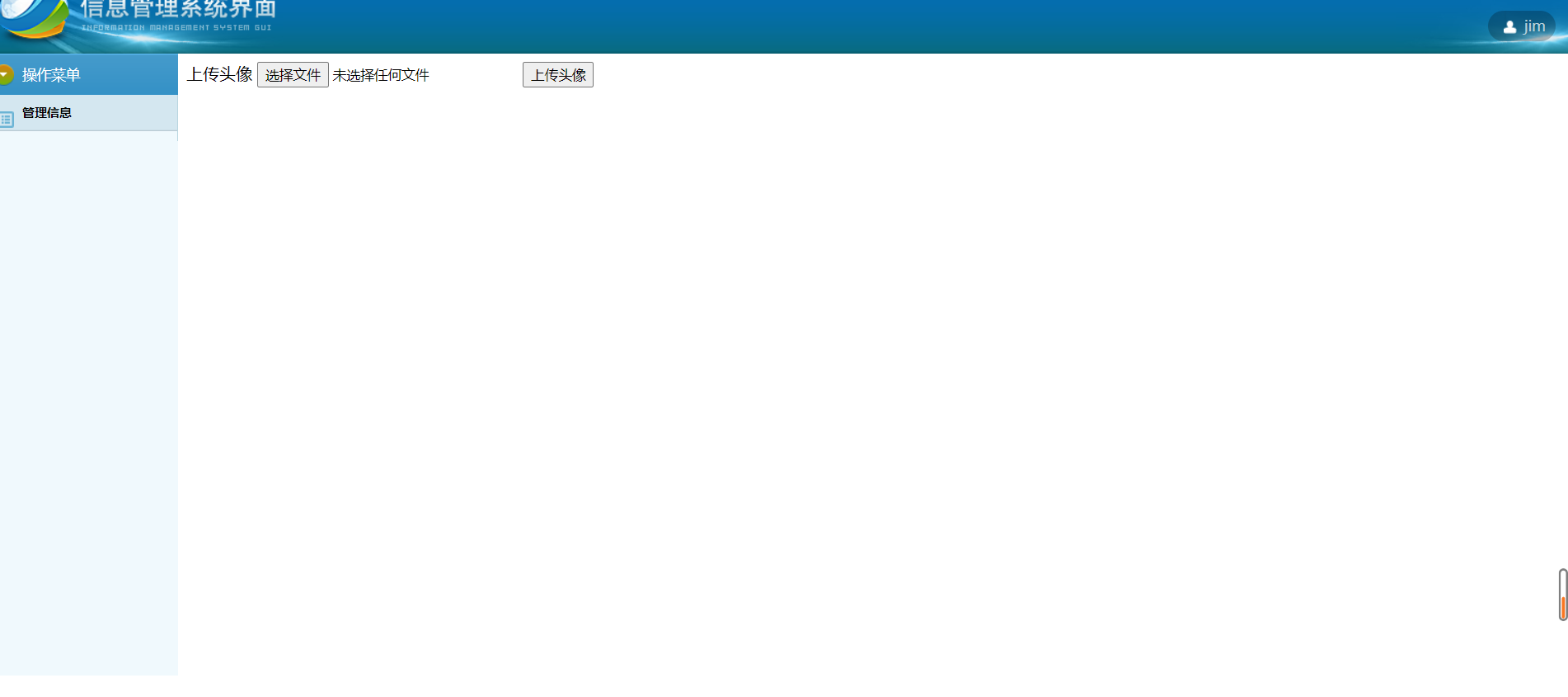
Through the server address access, we write the Service layer code. During this period, we have another problem, that is, how to avoid duplicate names of uploaded pictures?
We can write a util component to generate random numbers according to time for renaming images
Prevent duplicate names from adding Util component code
package com.qn.ssm.util;
import java.text.SimpleDateFormat;
import java.util.Date;
import java.util.Random;
import java.util.UUID;
import java.util.logging.SimpleFormatter;
public class Stringutil {
public static String subFileType(String fileName){
if (fileName!=null){
return fileName.substring(fileName.lastIndexOf(".")+1);
}
return null;
}
public static String newFileName(String oldFileName){
// UUID uuid=UUID.randomUUID();// A random number consisting of letters and numbers
Date date=new Date();
SimpleDateFormat sdf=new SimpleDateFormat ("yyyyMMddHHmmssSSS");
return sdf.format(date)+"."+subFileType(oldFileName);
}
}
package com.qn.ssm.controller;
import com.qn.ssm.common.CommonResult;
import com.qn.ssm.model.Admin;
import com.qn.ssm.service.AdminService;
import com.qn.ssm.util.Stringutil;
import org.springframework.beans.factory.annotation.Autowired;
import org.springframework.stereotype.Controller;
import org.springframework.web.bind.annotation.PostMapping;
import org.springframework.web.bind.annotation.RequestMapping;
import org.springframework.web.bind.annotation.RequestParam;
import org.springframework.web.bind.annotation.ResponseBody;
import org.springframework.web.multipart.commons.CommonsMultipartFile;
import javax.servlet.http.HttpSession;
import java.io.File;
import java.io.IOException;
@Controller
@RequestMapping(path = "/admin")
public class AdminController {
@Autowired
AdminService adminService;
/*apache File + spring MVC component*/
@ResponseBody
@PostMapping(path = "/fileUpload")
public CommonResult fileUpload(@RequestParam("fileName") CommonsMultipartFile file, HttpSession session){
CommonResult commonResult=null;
System.out.println(file.getOriginalFilename());
Admin admin=(Admin)session.getAttribute("admin");
File f0=new File("D:\\userimg\\admin\\"+admin.getAccount());
if (!f0.exists()){
f0.mkdir();
}
String oldFileName=file.getOriginalFilename();
String newFileName= Stringutil.newFileName(oldFileName);//Avoid duplicate file names and generate new file names
File f=new File(f0,newFileName);
try {
file.transferTo(f);
//Save the relationship between the user and the file, and respond the file address to the front end
Admin a=new Admin();
a.setId(admin.getId());
a.setNewFileName(newFileName);
a.setOldFileName(oldFileName);
adminService.updateAdmin(a);
commonResult=new CommonResult(200,"Upload successful",a);
// The stored file may have the same name. The relationship between the file and the account can be stored with the help of the database
} catch (IOException e) {
e.printStackTrace();
commonResult=new CommonResult(200,"Upload failed",null);
}
return commonResult;
}
}
Deploy gallery to server
Here, we can transfer the back-end interface through the file upload address. We also need to deploy the uploaded image files to the server
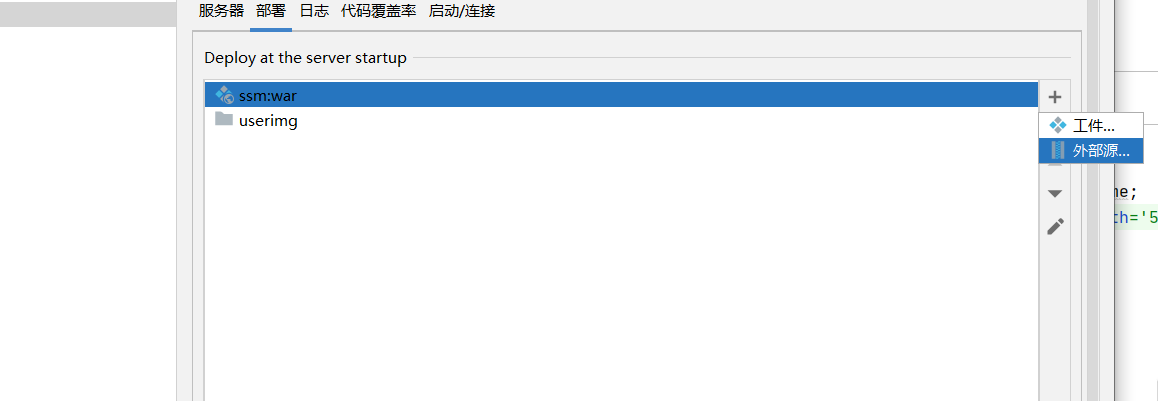
In this way, we can upload the pictures to the local gallery and then to the server
Add avatar to success interface
The last step is to obtain the image and bind the user's Avatar to the success interface through the database
Then success HTML add the following code
//Judge whether the user has a Avatar
if (newFileName != "null"){
var imgsrc="http://localhost:8080/userimg/admin/"+account+"/"+newFileName;
console.log(imgsrc);
document.getElementById("imgId").innerHTML="<img src='"+imgsrc+"' width='50' height='50'/>";
}
Start validation
Upload pictures, click upload

Log in again
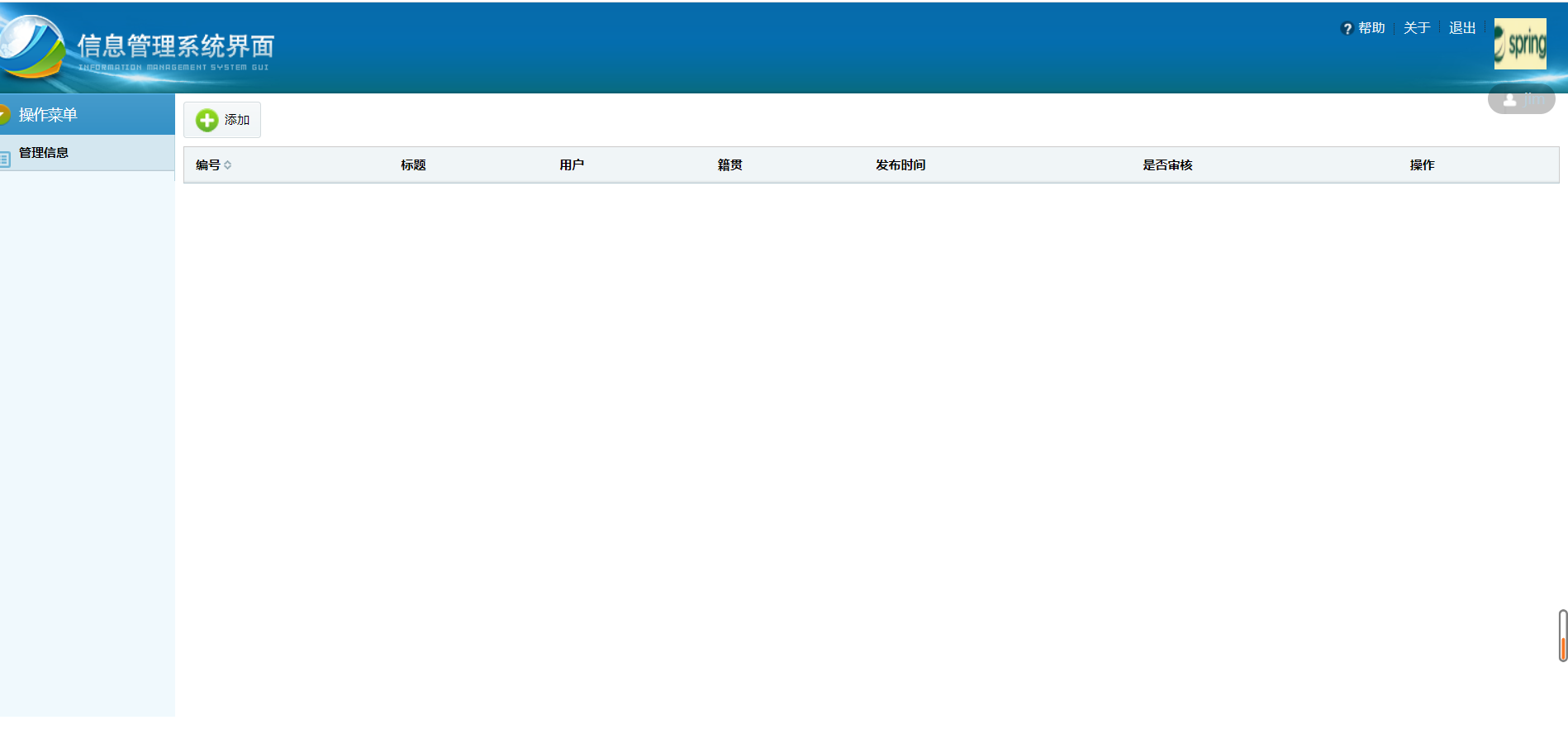
Upload successful